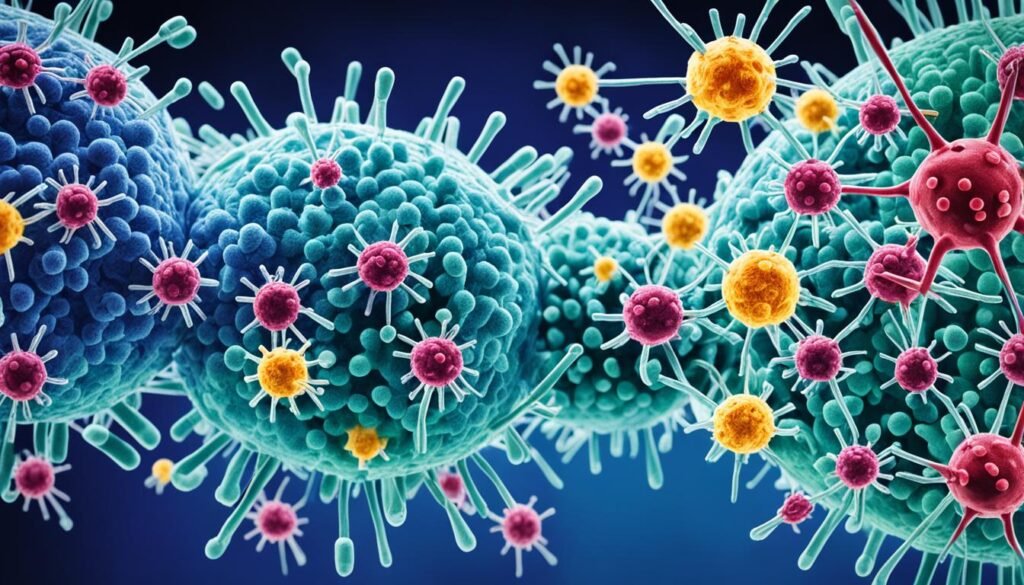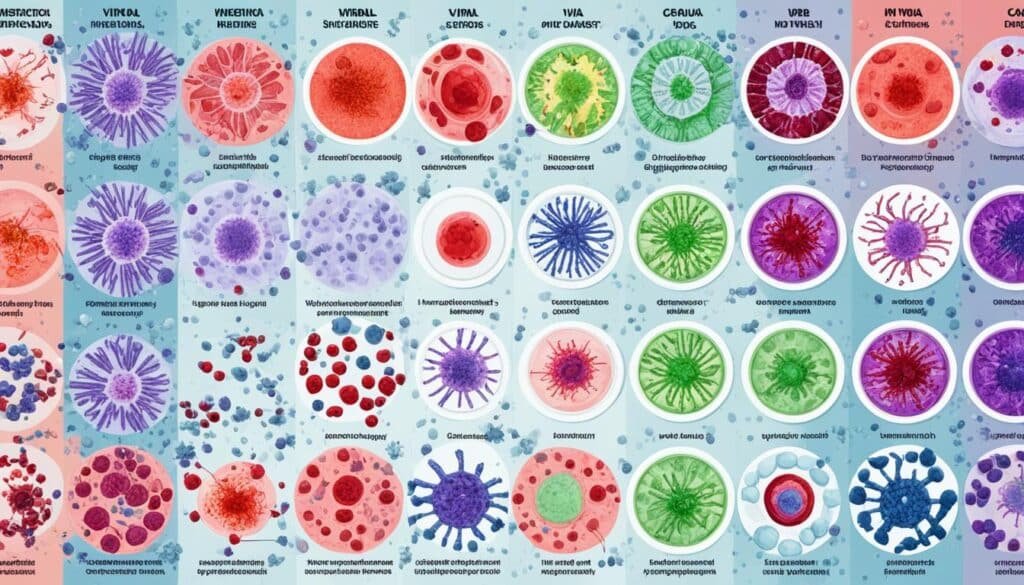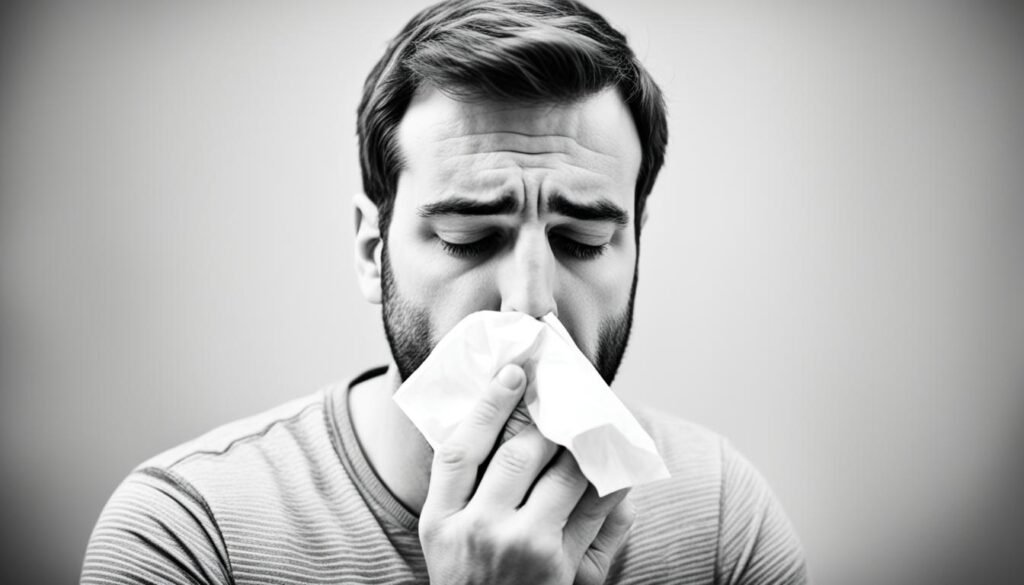Viral infections are illnesses spread by viruses. These tiny organisms can’t replicate on their own. They enter our bodies and make copies of themselves using our cells. This process often leads to various symptoms. People of all ages can catch these infections, but young kids, older adults, and those with weak immune systems are more at risk.
These infections can target various body parts. They might infect your respiratory system, digestion, skin, or nerves. The symptoms vary, from a mild cold to serious diseases like the flu or COVID-19. You can get a virus by touching infected people or surfaces, through insect bites, or from unprotected sex.
Key Takeaways
- Viral infections are contagious illnesses caused by viruses that hijack the host’s cells to replicate.
- Viral infections can affect various parts of the body and cause a wide range of symptoms.
- Certain groups, such as young children, older adults, and those with weakened immune systems, are more prone to viral infections.
- Viruses can spread through contact with infected individuals, contaminated surfaces, or other routes like insect bites and unprotected sex.
- Understanding the nature of viral infections and how they occur is crucial for prevention and effective management.
Understanding Viral Infections
A viral infection happens when a virus enters your body, making you sick. These viruses are very tiny. They can only be seen with a microscope. When they get inside your body, they use your cells to grow and multiply.
What Is a Viral Infection?
When a virus enters your body, it starts to spread. Unlike bacteria, viruses can’t be fought with antibiotics. This is why it’s important to know if you have a viral or bacterial infection. They can cause similar symptoms.
What Is a Virus?
A virus is a very small germ that can make you sick. It’s not like bacteria. It can’t reproduce on its own. It needs to get inside a living cell to multiply. This is how it makes you ill.
Understanding viruses is key to understanding illnesses they cause. When a virus gets into your cells, it takes over. It uses your cells to make more of itself. This can harm or kill your cells, leading to illness.
“Viruses are not living organisms, but rather genetic material enclosed in a protective protein coat. They can only replicate by infecting the cells of other living organisms.”
Viral and bacterial infections are not the same. Knowing the difference helps with treatment. Viral infections need different care. Knowing about viruses helps doctors and scientists fight against them.
How Viruses Cause Disease

Viral infections can make us sick by invading our cells. They use our cells to multiply and move to other body parts. This is how illnesses caused by viruses start.
When a virus infects a cell, it begins a process. First, the virus attaches to a cell’s surface. Then, it deposits its genetic material inside the cell. Next, the virus takes control of the cell to make more viruses, potentially harming or killing the cell. This leads to a person showing sickness symptoms.
- Virus attachment: The virus sticks to the cell’s surface, preparing to enter.
- Genetic material injection: It delivers its genetic instructions (RNA or DNA) into the cell.
- Hijacking cell machinery: The virus gets the cell to make new viral parts instead of the cell’s normal products.
- Viral assembly and release: New viruses are created and leave the cell to infect others.
“Viruses are obligate intracellular parasites, meaning they can only replicate inside the living cells of other organisms.”
This process of infection and spread is how viruses quickly make many people sick. To fight these viral diseases, we must deeply understand how viruses affect our cells. This is key to better treatments and stopping illnesses before they start.
The power of viruses lies in their ability to control our cell processes. Knowing how they infect cells and replicate helps us fight back. It’s essential in protecting our health from viral diseases.
Types of Viral Infections

Viral infections can hit different body parts and cause a variety of symptoms. This includes issues with respiratory, digestive, and other systems. It’s interesting to look at how these infections differ.
Respiratory Viral Infections
These infections affect the lungs, throat, and breathing passages. The common cold, flu, and COVID-19 are well-known examples. They bring on coughs, sneezes, high fever, and trouble breathing.
Digestive System Infections
Some viruses target the stomach, intestines, and liver. For example, norovirus and hepatitis cause nausea, vomiting, and stomach pain.
Viral Hemorrhagic Fevers
Viruses that cause hemorrhagic fevers affect the blood and vessels. Diseases like Ebola and Dengue can lead to dangerous bleeding, organ failure, and serious complications.
Sexually Transmitted Infections (STIs)
STIs like HIV, HPV, and herpes spread through sexual activities. They can have severe consequences if not dealt with.
Exanthematous (Rash-Causing) Infections
Viruses such as chickenpox and measles show up as rashes or blisters. They’re easily spread among people.
Neurological Infections
Some viruses affect the brain and nervous system. They can cause diseases like encephalitis and meningitis. Their effects can be long-lasting and severe.
Congenital Infections
A pregnant woman can pass viruses to her fetus, causing congenital issues. Diseases like Zika, rubella, and CMV result in birth defects and developmental problems.
It’s key to know about different viral infections for better prevention and care. Each type has its own features and effects. This knowledge helps healthcare workers and people manage the dangers of these diseases better.
How Viral Infections Spread
Viral infections spread in many ways, making them a huge threat to public health. It’s important to know how they spread to stop their reach and keep us safe.
Viruses can travel through the air by tiny droplets produced when an infected person coughs, sneezes, or talks. This kind of spread is fast, especially in crowded rooms or closed spaces.
Viruses can also spread by touching things an infected person has touched. If you then touch your face, mouth, or eyes, the virus can infect you. This is why washing your hands is very important.
Eating or drinking something that’s been contaminated can pass on some viruses. This can affect our stomachs. So, it’s crucial to handle food and water safely to avoid getting sick.
Certain viruses can travel through insect or animal bites. For example, mosquitoes can pass on viruses like Zika. And some can be spread through sex, meaning you can catch them from a partner.
If a pregnant woman has a viral infection, she can pass it to her baby. This shows why prenatal care is key for the health of both the mother and her child.
Knowing how viruses spread helps us protect ourselves and others. We can take steps to avoid getting sick, which helps make our communities healthier.
| Transmission Method | Examples of Viral Infections |
|---|---|
| Airborne (coughing, sneezing, talking) | Influenza, COVID-19, Measles |
| Contaminated Surfaces | Norovirus, Hepatitis A |
| Contaminated Food or Water | Hepatitis A, Rotavirus |
| Insect or Animal Bites | Zika virus, Dengue fever |
| Unprotected Sexual Contact | HIV, Herpes Simplex Virus |
| Congenital Transmission | Rubella, Cytomegalovirus |
Being aware of how viral infections spread empowers us. It allows us to protect ourselves and those around us, making our community healthier and safer.
Viral Infection Symptoms

Viral infections show different symptoms based on the type of virus and body part affected. Knowing common viral illness signs is key to spotting possible infections. It also helps in getting medical help when needed.
Respiratory problems are a widespread feature of viral infections. They include a cough, a sore throat, a runny nose, and a fever. If your digestive system is hit, you might feel nauseous, vomit, have diarrhea, or suffer from stomach pain.
Viruses can cause severe problems, too. For example, some can lead to viral hemorrhagic fevers. These are very dangerous and can make you bleed a lot and get big bruises. Sexually transmitted viruses can show up as sores, odd fluids, or pain when peeing.
The skin and the nervous system can also be targets. Skin infections might look like rashes or blisters. Neurological viral problems could cause a headache and make you feel confused. Some viral infections may seem harmless but can be risky if not treated.
Common Viral Infection Symptoms
- Respiratory infections: Cough, sore throat, runny nose, fever
- Digestive system infections: Nausea, vomiting, diarrhea, abdominal pain
- Viral hemorrhagic fevers: Severe bleeding, bruising
- Sexually transmitted infections: Genital sores, abnormal discharge, pain with urination
- Skin infections: Rashes, blisters, discoloration
- Neurological infections: Headache, fever, neck stiffness, altered mental status
“While some viral infections are mild, others can become quite severe and even life-threatening if left untreated.”
It’s vital to know the signs of viral infections. This helps in quickly getting the right medical care. It also stops the sickness from spreading. By learning the many symptoms, people can notice and deal with viral infections to protect their health.
Who Is at Risk for Viral Infections?

Viral infections can affect anyone, but some people are at higher risk. It’s important to know these risks to prevent getting sick. This knowledge can also help get medical help when needed.
Infants and young children under 5 and older adults over 65 face more dangers. This is because their immune systems are weaker. As we age, our bodies find it harder to fight viruses.
Weakened immune systems also put people in danger. This includes those with HIV/AIDS or cancer patients. Such conditions can make it hard for the body to fight viruses off well.
Those with chronic medical conditions, like diabetes or asthma, face risks too. Such diseases can weaken the body against viruses. This could lead to very serious illness.
Pregnant women are at risk due to their changing immune systems. Not only can they get sick easier, but the virus could also harm their baby.
Despite the risks, there are steps to lower the chances of catching a virus. Good hygiene, avoiding sick people, and safe food and water practices are key. These actions can protect you and others from getting ill.
| High-Risk Group | Reasons for Increased Susceptibility |
|---|---|
| Infants and young children under 5 | Underdeveloped immune systems |
| Older adults over 65 | Weakened immune systems due to aging |
| People with weakened immune systems | Compromised ability to fight off viruses |
| Individuals with chronic medical conditions | Underlying health issues that can worsen viral infections |
| Pregnant women | Changing immune systems during pregnancy |
Knowing who’s at risk for viral infections is a big help. It means being able to act early to keep the most vulnerable safe. And it ensures quick and effective care when sickness does strike.
Diagnosing Viral Infections

Figuring out if someone has a viral infection is key. It helps doctors know what’s wrong and how to treat it. They use different ways to find out, like looking at the patient, doing tests, and sometimes using pictures of the inside of the body.
First, they look closely at the patient’s body and check their medical history. They might see a fever, cough, or rash. These could give hints about which virus is causing the sickness. They will also ask where the patient has traveled or who they’ve been near lately.
Doctors also take samples to test in the lab. They might swab a person’s nose or throat or take a little blood. These samples help them see if the virus or its signs are there. This confirms which virus is the problem.
Sometimes, they might take pictures inside the body, like X-rays. This can show if the virus is causing harm to the organs. It helps doctors make sure they’re focusing on the right cause and how to treat it.
Getting the right diagnosis quickly is important. It means the patient can get the right care and others are safe from getting the virus. Mixing physical exams, lab tests, and sometimes images is a strong way to figure out what virus is making someone sick. This leads to better plans for treating the patient.
| Diagnostic Approach | Purpose |
|---|---|
| Physical Examination | Observe symptoms and gather medical history |
| Laboratory Testing | Detect the presence of the virus or viral antibodies |
| Imaging Tests | Assess internal organ involvement and complications |
Doctors use all these tools to truly understand a viral infection. This way, they can choose the best way to help their patients. It’s a team effort that works well to find and fight viruses.
Also Read : Cancer Symptoms: A Guide To Early Detection And Action
Treating Viral Infection

Treating viral infections mainly involves managing symptoms. The body’s natural healing is key. Most infections will go away with rest and proper care. The focus is on making the patient comfortable and avoiding further problems, not on killing the virus.
Rest is vital when fighting a virus. Giving the body time to heal is essential. Also, drinking lots of fluids is important. It helps the body work better and flush out toxins.
- Get plenty of rest
- Stay hydrated by drinking fluids
- Take over-the-counter medication for fever, pain, and congestion
- Avoid contact with others to prevent spreading the infection
For more serious viral cases, doctors might use antiviral medicines. These can lessen symptoms and help avoid complications. However, remember, antibiotics don’t work on viruses; they fight bacteria only.
Preventing viral infections with vaccines is still very important. Vaccines teach the body to fight specific viruses. This reduces infection risks and symptom severity.
“Supportive care and prevention through vaccination are the mainstays of viral infection management.”
Rest, hydration, and managing symptoms, plus antiviral medicines when needed, help against viral illnesses. Good hygiene and getting vaccinations are also vital. They keep viruses from spreading.
Conclusion
Viral infections are a common health risk for everyone. They are caused by tiny germs that invade our cells. This can lead to many health problems, from coughs to serious sickness.
It’s important to know that viruses need our cells to make more of themselves. They cause a wide range of symptoms. While most get better with time and care, some need special medicine.
We must work hard to spot and treat these infections. This helps keep everyone healthy. By learning more, we can protect ourselves and others. We should also follow steps to stop the viruses from spreading.
FAQs
Q: What is a viral infection and how does it occur?
A: Viral infections occur when a virus enters your body and invades your cells, using them to multiply and spread throughout your body. This can happen through various means such as respiratory droplets, direct contact, or ingestion of contaminated food or water.
Q: What are the differences between bacterial and viral infections?
A: Bacterial infections are caused by bacteria, while viral infections are caused by viruses. Bacterial infections can be treated with antibiotics, but antibiotics are not effective against viral infections. Additionally, bacterial infections typically affect specific parts of the body, whereas viral infections can affect multiple systems.
Q: How are viral infections diagnosed?
A: Viral infections are usually diagnosed through a combination of symptoms, physical examination, and specific laboratory tests such as blood tests, cultures, or molecular techniques to detect the presence of the virus in the body.
Q: What are some common viral infections?
A: Many viral infections are common, including the flu, COVID-19, HIV infection, respiratory infections, skin infections, and gastrointestinal infections. These infections can cause a wide range of symptoms and severity levels.
Q: How are viral infections treated?
A: Most viral infections are self-limiting and resolve on their own with rest, hydration, and symptom management. In some cases, antiviral medications may be prescribed to help shorten the duration of the infection and reduce the severity of symptoms.
Q: Can viral infections be prevented?
A: Yes, some viral infections can be prevented through vaccination. Vaccines help your immune system recognize and fight off specific viruses, reducing the risk of developing an infection or experiencing severe symptoms if you do get infected.
Q: What role do host cells play in viral infections?
A: Viruses rely on host cells to replicate and spread within the body. They hijack the host cell’s machinery to produce more viral particles, which can then infect other cells and continue the infection cycle.
Source Links
- https://medlineplus.gov/viralinfections.html
- https://my.clevelandclinic.org/health/diseases/24473-viral-infection
- https://www.health.com/viral-infection-8401452




